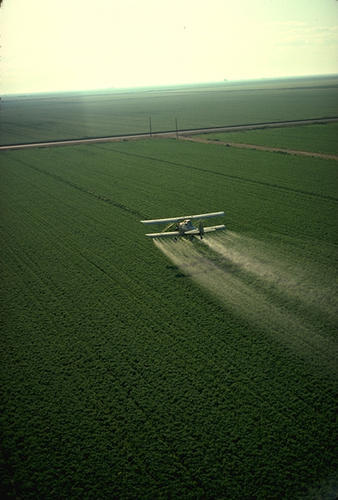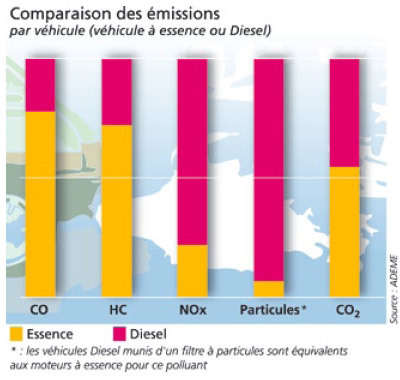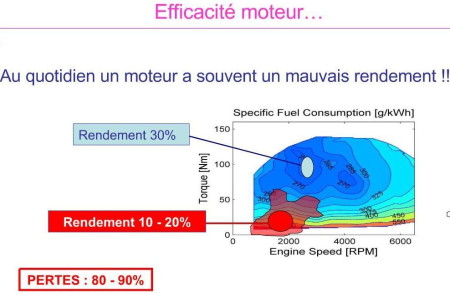What will be the fuels of tomorrow for our cars: the limits of agro and biofuels? by O.Daniélo
Ticket written for The human Network (Cisco).
Thanks to Marguerite de Durant as well as Thibault Souchet from SpinTank.fr for their collaboration (BFM TV etc.).
Christian Matke (Chile) is currently translating this text into Spanish.
A debate on this theme follows a post from Isabelle Delannoy on her blog.
Un debate on the forum Econology ("The pros and cons of the electric car")
A debate on the forum Air-Car-Concept (forum which deals with compressed air cars)
From Singapore to Los Angeles, from Paris to Mexico City, city dwellers around the world are today suffocated by automobile pollution. The famous and smoky internal combustion engines of current vehicles pose serious health problems, they emit toxic particles and gases and are very noisy. According to the European Commission, more than 400 Europeans die prematurely each year from air pollution, and this pollution [1] also has an impact on the productivity of workers, an impact with consequences estimated at several billion euros. Automobile pollution kills more than road accidents. In addition, these heat engines intrinsically have a very low efficiency, 20% in the use cycle of motorists (18% for the gasoline engine, 23% for the diesel engine; in the laboratory, under ideal conditions, slightly higher efficiency. high were obtained). This means that when you buy a liter of fuel, only a fifth of that liter will actually advance your vehicle, the rest will be wasted. Interesting for the one who sells the fuel, much less for the one who buys it ...
What to expect from agrofuels?
 |
Concerning the car that will roll on our roads tomorrow, some people are basing their hopes on agrofuels. Remember that to obtain agrofuels, you have to grow plants! However, plants (cereals, oilseeds, trees, etc.) have an efficiency of converting solar energy into chemical energy (biomass) of less than 1%. Whatever the sector envisaged, whether for first or second generation agrofuels, and whatever the agents or processes used for the transformation (bacteria, fungi, termites, enzymes, pyrolysis, gasification, ethanolic fermentation, trans-esterification etc ...), this physical limit upstream is essential, even with the most efficient GMOs which, moreover, are not necessarily desirable. Energy is not created, it is transformed (first principle of thermodynamics). Let us add that once the biomass is obtained, it must be collected and then transformed into agrofuel, resulting in very high energy consumption and sometimes almost equal to the energy content of the obtained agrofuel ... Finally, new losses inevitably occur at the level heat engine. Whether it runs with gasoline or with cellulosic ethanol, with petro-diesel or with agro-diesel, the efficiency of a heat engine remains low. |
The overall balance of the energy chain "from the sun to the wheel" is 0,08% with biofuels, or 100 times less than with the solar-electric car sector. [4]. Even if the efficiency of the heat engine were to be multiplied by 2 in the next 20 to 30 years, the overall balance of the chain would remain very low. As underlined in the report "Agrofuels and Environment" published at the end of 2008 by the Ministry of Ecology, "Agrofuels are located in the zone of the lowest yields, they are in fact limited by the yield of photosynthesis which is very low. (<1%). The third generation, using algae, will remain much less efficient than any “electric” solutions, especially the use of solar energy. " 5
Such poor performance has important environmental and social consequences: it means growing large areas. To replace the 50 Mtep (million tons oil equivalent) burned each year in transport in France, it would grow 120% of the total area of France! [6] The equation is untenable; the areas needed being immense, we are seeing in countries which are massively developing agrofuels, such as Indonesia [7] or Brazil [8], has deplorable practices: use of land which was intended for food crops, expropriation of small landowners, massive deforestation which leads to dramatic consequences in terms of biodiversity. In addition, and we too often forget, crops are large consumers of fresh water, a precious resource that is less and less available in many regions of the planet and the world population is increasing. Finally, large quantities of pesticides (photo opposite) and fertilizers are used in energy crops and their environmental impact is also worrying (chemical water pollution, eutrophication, etc.). A study published in the journal Environmental Research Letters on January 13, 2009, carried out in 238 countries, states or territories under the direction of Matt Johnston and covering 20 cultivated species has shown that up to now we have been overestimated by a factor of 2 the ethanol yields obtained by many plants: corn, wheat, sorghum, barley, cassava, sugar beet; the same goes for the oil yields for Jatropha, coconut, peanut, sunflower, rapeseed etc. [9 and 10]
The Department of Energy and Atmosphere at Stanford University has published 2008 a multi-criteria study 11 allowing a serious comparison of the various renewable energies likely to meet the needs of the transport sector. Criteria used: CO2 emissions, consumption of fresh water, chemical pollution, surfaces used, impact on biodiversity, etc. It emerges from this major study that agrofuels have the poorest track record. It should be noted that the combustion of agrofuels poses serious health problems, which is anything but negligible [12]. Biofuels should therefore only be used as a substitute for petroleum for applications where one cannot do otherwise: long-haul aircraft for example. Microalgal fuels (which, however, remain very expensive today, 10 euros per liter according to the Shamash research team) offer interesting prospects for this type of application. However, no assessment of the environmental impact of this type of cultivation has been carried out to date. Most companies that develop these technologies use genetically modified microalgae. What will happen if these GMO microalgae are found in nature?
There are plants that grow in arid areas. This is the case, for example, with Jatropha curcas. But these plants, despite their remarkable resistance, are living beings like any other: without water and fertilizer, they survive and have low productivity. Experiments were carried out several years ago in arid zones with the Mexican variety of Jatropha curcas by Mexican agricultural engineers. Conclusion of the experiments: without regular water supply, the yields are extremely low and unprofitable. And water is a precious resource in arid zones… Today, in poor or even very poor regions, we are witnessing the mass cultivation of good land with Jatropha curcas, land where we can cultivate food plants. . Castor, a plant, like Jatropha curcas, of the euphorbiaceae family, is for example cultivated today in Ethiopia, instead of food crops! The international network for access to sustainable energies denounces the consequences of these practices for local populations [Ethiopia: peasants scalded by the promises of biofuels 13]. Growing Jatropha curcas or, better, the nitrogen fixing tree Pongamia pinnata (pongamia pinnata), is of interest to disadvantaged populations who cannot, for example, acquire photovoltaic panels to produce electricity. (pongamia pinnata) With oil, these populations can supply a generator. The electricity obtained makes it possible to meet basic needs: produce cold to store medicines and food, power a computer to have access to information, etc. The oil can be used to power the engine of a water pump or a multi-function platform. It can also be used as a raw material for artisanal soap making and thus improve hygienic conditions. The Breton sailor and ecologist Jo Le Guen, for example, has set up a project that is truly socially relevant in Burkina-faso, "Vivre au village" [15]. On the other hand, in Africa, Asia and South America, the exploitation of land and disadvantaged local populations by companies that sell Jatropha oil in the United States or Europe to make automotive fuels is nonsense. total in social and ecological terms.
In the world of agrofuels, only the way to recover waste in biogas remains relevant. But the most efficient way to use this biogas is not to burn it in the engine of a specially equipped vehicle, but in a cogeneration plant that produces electricity + heat, electricity that powers electric cars. Note also that if all the waste produced in France (urban and industrial wastewater treatment plants, landfills, solid and assimilable waste including waste from the food industry, agricultural digesters) were recovered in biogas, we would obtain 3,3 million tonnes of oil equivalent (SOLAGRO, high estimate [16]); The transport needs are 50 Mtep in France.
The following to come.
References and sources





From now on, it will also be necessary to rely on solar hydrogen produced at a lower cost in semi-desert regions that can be transformed into “energy vectors” that are much less expensive to transport to urbanized regions.
Thus, ammonia, iron ore reduced to primary steel, hydrocarbon molecules ...
In which case, for transport, the figures to remember concerning the conversion efficiency of solar energy will be much less unfavorable: in 2020, the efficiency of photovoltaic panels already reaches 20%, the synthetic fuels obtained would therefore be 8 or even 10% of the starting solar energy.
Thus, the useful mechanical energy would be 2, or even 3%, compared to the 10 to 12% of the “all-electric” battery sector.
Because, it must be said, in many cases, the "all electric" has many drawbacks ...